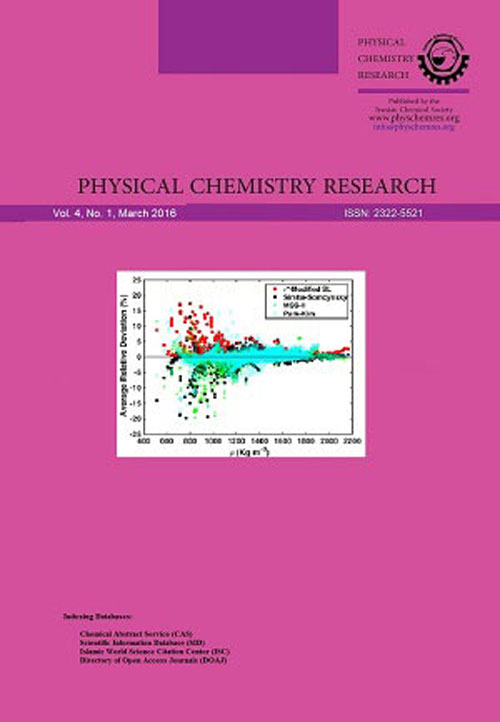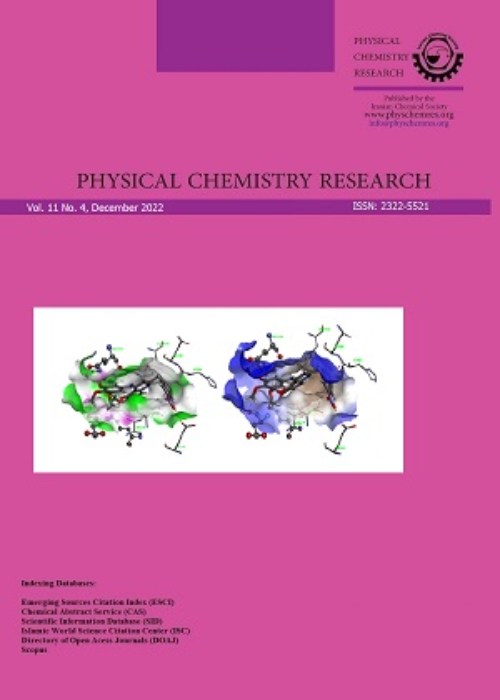فهرست مطالب

Physical Chemistry Research
Volume:4 Issue: 1, Winter 2016
- تاریخ انتشار: 1394/09/23
- تعداد عناوین: 10
-
-
Pages 1-15
The effects of substituents on the symmetry and the nature of halogen bonds in [N∙∙∙X∙∙∙N]+type systems are presented for the YC5H4N∙∙∙X∙∙∙NC5H5 (Y = NO2, CN, H, CH3, OCH3, OH, NH2, X = Cl, Br, I) complexes. Some structural parameters, energy data and electronic properties were explored with the density functional theory (DFT) calculations. In addition, electrostatic potentials were used in estimation of the strength and the nature of halogen bonds. Results indicate an enhancement effect of the electron-withdrawing substituents on the size of σ-hole and a diminishing effect on the minimum negative electrostatic potential (VS,min). A good correlation is observed between the electrostatic potentials and the strengths of two N···X halogen bonds. Furthermore, the results unveiled the effects of the substituents in changing the nature of halogen bonds and indicated that the halogen bonds have a tremendous covalent character in addition to the electrostatic character that usually is considered for the halogen bonds.
Keywords: Halogen-bonding, Bis(pyridine)halonium, σ, Hole, Electrostatic potentials, DFT -
Liquid Density Modeling of Pure Refrigerants Using Four Lattice-Hole Theory Based Equations of StatePages 17-33
The present study investigates the performance and relative accuracy of four lattice-hole theory based equations of state in modeling and correlating the liquid density of pure refrigerants. Following the gathering of a database of 5740 experimental liquid density datapoints of 36 pure refrigerants belonging to five different categories including CFCs, HCFCs, PFCs, HFCs and HFEs, ranging from 6 × 10-5-500 MPa and 94-533 K, the pure component characteristic parameters of the EOSs were estimated and used in their comparative study. According to the results obtained, all the four EOSs can satisfactorily represent the liquid density of refrigerants with AARDs of only 0.654%, 0.684%, 0.798% and 0.859% for ε*-Modified Sanchez-Lacombe, Simha-Somcynsky, MSS-II and Park-Kim EOSs, respectively. Also, based on a comparison with the commonly used Peng-Robinson, as well as the linear isotherm regularity (LIR) EOSs, with AARDs of10.064% and 2.050%, respectively, in representing the liquid density data, it can be concluded that the large improvements obtained when using the lattice-hole theory based EOSs do justify the use of these more complex equations of state for modeling the volumetric properties of various pure refrigerants.
Keywords: Liquid density, Refrigerant, Lattice, hole theory, Equation of state, Statistical thermodynamics -
Pages 35-46
Polythiophenes are of considerable interest as synthetic metals. The optical properties of polythiophenes can be easily affected by alkyl chain or other side groups to the thiophene ring. The effect of polymerization degree on the energy gap was studied in the case of polythiophene as a conjugated polymer at B3LYP/6-31(3d,3p) level of theory. Up to n = 16 could be confident that this degree of polymerization represents the bulk of polymer. The effect of the substitution of different groups in functionalized-bithiophene and -terthiophene on the polarizability was studied. The correlation study was performed between descriptors representing the molecular structure and refractive index for the set of 9 oligothiophenes. Three descriptor models including energy gap, polarizability and heat of formation were developed to estimate the refractive index with R2 = 0.81 and S = 0.068 by multi-linear regression analysis. The obtained model was used to predict the refractive indices of other six oligothiophenes. The model may be improved to predict the refractive index of the other oligothiophene derivatives.
Keywords: Oligothiophene, Correlation, Refractive index, Optical properties, DFT -
Pages 47-60
To investigate the interaction and adsorption of drug and carbon nanotube on human serum albumin, three anti-cancer drugs ([Pd(phen)(R-gly)]NO3, R = methyl, propyl and amyl) with different hydrophobic tails and anticancer activities were selected. These drugs have better anti-tumor activity and less side effects than that known cis-platinum drug. Human serum albumin is also important for drug delivery and release and acts as carrier of internal biological molecules and external drugs that bind to many drugs in blood route and carry them. Drug binding to human serum albumin can change its helicity and this can affect on the drug release and distribution. Thus, study of this aspect can provide structural features determining the therapeutic efficiency of drug that has the least effect on human serum albumin helix structure. Interaction of three drugs with human serum albumin was investigated by molecular dynamics simulation and the best drug with the least denaturation effect was selected to compare its effect in the presence of nanotube. The structure of protein was again compared in the presence of drug and nanotube. The results revealed less denaturation effect of methyl on human serum albumin structure. The denaturation of protein also decreased more in the presence of nanotube. Carbon nanotube can be used as a cover for denaturation effect of drug and leads to better orientation and less random movement of drug around protein. It also reveals drug interaction with protein binding site facilitated in the presence of carbon nanotube.
Keywords: Molecular dynamics simulation, Human serum albumin (HSA), Helix, carbon nanotube (CNT), Denaturation -
Pages 61-71
The quantitative structure-property relationship (QSPR) method is used to develop the correlation between structures of refrigerants (198 compounds) and their critical temperature. Molecular descriptors calculated from structure alone were used to represent molecular structures. A subset of the calculated descriptors selected using a genetic algorithm (GA) was used in the QSPR model development. Multiple linear regressions (MLR) were utilized to construct the linear prediction model. The prediction result agrees well with the experimental value of this property. The comparison results indicate the superiority of the presented model and reveal that it can be effectively used to predict the critical temperatures of refrigerant compounds from the molecular structures alone. The stability and predictivity of the proposed model were validated using internal validation, external validation and Y-scrambling. Application of the developed model to a testing set of 39 organic compounds demonstrates that the new model is reliable with good predictive accuracy and simple formulation. The R2, RMSEtr and Q2loo values for the training set were 0.9752, 13.8994 and 0.9742; Q2ext and RMSEpr for test set were 0.9766 and 12.8654 for GA-MLR model, respectively. The prediction results are in good agreement with the experimental values. In addition, the applicability domain (AD) of the model was analyzed based on the Williams plot.
Keywords: Refrigerants, Critical temperature, QSPR, GA-MLR, Prediction -
Pages 73-82
Antioxidants are made for the struggle and reconstruction of the damaged cells, because of their ability in destroying the free radicals. On account of their importance, a theoretical procedure was applied for the study of the molecular structure and radical scavenging activity of six hydroxyphenols which have been introduced as antioxidant compounds. All geometry structures were optimized by M06-2X, MPWB1K with 6-311 (d, p) basis in the gas phase and solvent using the CPCM model. Three probable mechanisms for the antioxidant activities have been presented and analyzed. According to bond dissociation enthalpy (BDE) and ionization potential (IP) values, hydrogen atom transfer (HAT) mechanism is a more reasonable path for antioxidant activity. The contribution of the HOMO-LUMO orbitals and spin density distribution have been calculated for evaluating of the previous data. Finally, based on the comparison of the experimental and the calculated data, BDE mechanism showed the best agreement.
Keywords: Antioxidants, Bond dissociation energy, Density Functional Theory, Hydrogen atom transfer, Ionization potential -
Pages 83-94
The aggregation behavior of anionic Cobalt(II) 4,4′,4ʺ,4‴-tetrasulfonated phthalocyanine, [Co(TSPc)4-] was studied at its various concentrations and different ionic strengths using optical absorption and resonance light scattering (RLS) spectroscopies in 5 mM phosphate buffer, pH 7.0 at 25 °C. The results show no aggregation behavior at concentration range of 5.1 × 10-6-7.5 × 10-5 M. Also, the interaction of [Co(TSPc)4-] with calf thymus DNA (ct-DNA) was studied by UV-Vis absorption, fluorescence spectroscopies and thermal denaturation measurement. The binding constants were obtained at various ct-DNA concentrations using SQUAD software. The thermodynamic parameters were calculated by the vant Hoff equation. The results show that the process is entropy-driven. The fluorescence study represents the quenching effect of [Co(TSPc)4-] on bound ethidium bromide (EtBr) to ct-DNA.
Keywords: DNA, Phthalocyanine, SQUAD, Thermodynamic, Fluorescence -
Pages 95-107
DFT-GGA method of Perdew-Burke-Ernzerhof (PBE) is used with aug-cc-PVTZ, 6-311**, and Def2-TZVP large basis sets to study the hydrogen bond interactions between oxygen lone pair as a donor electron with hydrogen atom connected to the anilines nitrogen as an electron acceptor (H2O···HNH-Ph), and nitrogen lone pair with hydrogen of water molecule (Ph-H2N···HOH), both in the gas phase. In some cases, MP2/Def2-TZVP is also carried out to test the results of DFT. To analyze donor-acceptor interactions of two above hydrogen bonds, natural bond orbital (NBO), natural energy decomposition analysis (NEDA), natural population analysis (NPA), and quantum theory of atoms in molecules (QTAIM) methods have been used in a detailed manner. Results show that the hydrogen bond in PhH2N···HOH is partially covalent, while hydrogen bond in PhHNH···OH2 is totally electrostatic. For the PhHNH···OH2 complex, there is a large gap between MP2 and PBE results which can be filled by incorporating dispersion terms in the DFT calculations. In all calculations, nitrogen atom of aniline is an stronger electron donor than the oxygen atom of water in the gas phase. PhH2N···HOH has higher electron density than PhHNH···OH2. NBO data shows that the stabilization energy due to the charge transfer for HOH···NH2Ph complex is more than that in H2O···HNHPh complex. The inversion barrier energy was also calculated at the level of PBE/Def2-TZVP without and with dispersion term, and results show that the barrier energy for PhH2N···HOH and PhHNH···OH2 complexes, are about 104 and 103 kcal mol-1, without, and 8.14 and 7.03 kcal mol-1, with dispersion, respectively.
Keywords: Hydrogen bond, NEDA, QTAIM, NBO, Aniline, water complex -
Pages 109-117
In this study, the interaction between NO2 cation and Hen (n = 1-7) clusters is investigated by means of ab initio calculations at MP2/aug-cc-pVTZ and QCISD/aug-cc-pVTZ computational levels. The first and second solvation shells were obtained while N atom of NO2 interacts with five and two He atoms, respectively. Stabilization energies of the studied complexes including basis set superposition errors (BSSE) and zero-point energy (ZPE) corrections at MP2/aug-cc-pVTZ level are in the range of 1.5-7.6 kJ mol-1. Energy decomposition analysis (EDA) shows that polarization effects are the main source of the attraction energy in these complexes. The second most important attraction term is dispersion energy.
Keywords: Microsolvation, NO2+, He, Ab initio, EDA, Blue shift -
Pages 119-141
The density (d), speed of sound (u) and electrolytic conductivity (Λ) for systems containing acetaminophen, ionic liquid {1-octyl-3-methyl imidazolium bromide, [OMIm] Br} and water have been measured at T = 293.15-308.15 K. The measured data have been applied to calculate, standard partial molar volume ( ), Heplers constant , apparent molar isentropic compressibility (Kφ), transfer volume ( ), transfer compressibility ( ) and hydration number (nH), and used to discuss various solute-solvent interactions. The transfer quantities are positive and increase with molalities of ionic liquid and decrease with temperature, indicating the dominance of hydrophilic-hydrophilic interactions between the ionic liquid and acetaminophen, and dehydration effect of ionic liquid on the solutions. The limiting molar conductivities ( ) and ion association constants (Ka) for [OMIm]Br in aqueous acetaminophen solutions have been estimated using low concentration Chemical Model (lcCM). The Ka values were also used to obtain the thermodynamic functions of association process. Thermodynamic results show that the formation process of ion association of the ionic liquid has endothermic nature and is driven by the change in entropy.
Keywords: Acetaminophen, Ionic liquid, Apparent molar volume, Molar conductivity


